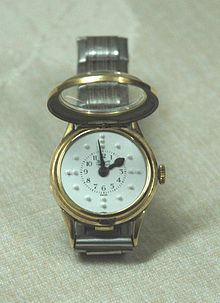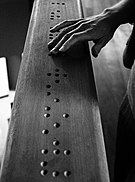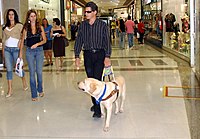Blindness
Blindness or invidity, is a sensory disability that consists of the total or partial loss of the sense of sight. There are several types of partial blindness depending on the degree and type of vision loss, such as reduced vision, scotoma, partial blindness (in one eye), or color blindness.
Types of blindness
- Blinds: are those subjects who have only perception of light, without projection, or those who lack totally vision. From the educational point of view, blind is the one who learns braille system and cannot use his vision to acquire any knowledge, although the perception of light can help him for his movements and guidance.
- Partial blinds: are those subjects that maintain greater visual possibilities, such as light perception capacity, lump perception and contours, some shades of color, etc.
- People with low vision: are those who keep a visual rest that allows them to see objects a few centimeters. These should never be called blind or educated as such, even if they have to learn "dactile" procedures to increase their knowledge. Visual disabilities such as myopia can enter within this range, especially if it is magna or pathological (over 6 diopters).
- Visual limitations: are those who need, due to their difficulties in learning, lighting or presentation of more suitable objects and materials, using lenses, increasing lighting, etc. In this range the ametropies enter.
Causes of blindness
According to the WHO estimate in 2002, the most common causes of blindness around the world are:
- Catarata
- Glaucoma
- Uveítis
- Macular degeneration
- Corneal opacity
- Tracoma
- Diabetic Retinopathy
Abnormalities and damage
In Spain, accidents, especially in those under 30 years of age, generally cause loss of sight in one of the eyes.
People with damage to the occipital lobe, despite having intact eyes and optic nerves, would have partial or total blindness.
Genetic defects
- People with albinism usually suffer from impairment to the extent of partial blindness, although few have total blindness.
- Congenital Leber atherosis can cause total blindness or great loss of vision from birth or childhood.
- Aniridia. Congenital lack of the iris of the eye.
Recent discoveries in the human genome have identified other genetic causes of low vision or blindness. One of them is the Bardet-Biedl syndrome.
Waterfalls
Cataracts are the congenital and pediatric pathology that describes the graying or opacity of the lens, which is most frequently caused by intrauterine infections, metabolic disorders, and genetically transmitted syndromes. Cataracts are the leading cause of blindness in children and adults, the prevalence of which doubles every 10 years after the age of 40. Consequently, cataracts are now more common among adults than among children, meaning that people are more likely to develop cataracts as they age. they get old However, cataracts tend to take a greater financial and emotional toll on children, requiring costly diagnosis, long-term rehabilitation, and visual assistance. Additionally, patients sometimes experience irreversible amblyopia after surgery. of pediatric cataracts because they prevented the normal maturation of vision before the operation. Despite great progress in treatment, cataracts remain a worldwide problem in both economically developed and developing countries. Today, With variable results and uneven access to cataract surgery, the best way to reduce the risk of developing cataract is to avoid smoking and prolonged exposure to sunlight.
Poisoning
Certain chemicals, such as methanol (burning alcohol), which is used to adulterate alcoholic beverages.
Others
Malnutrition and disease are the main causes of blindness. Exposure to environments that require great visual effort for long periods of time.
Epidemiology
In 2002, the WHO (World Health Organization) estimated that there were 162 million people (2.6% of the world population) in the world with vision impairment, of which 124 million (2% approximately) had low vision and 37 million were blind (about 0.6%).
Prevention
There are organizations that have developed programs to prevent blindness. It is recommended to go to the eye doctor every 6 months for a vision checkup.
Other visual impairments
In addition to total blindness there is low vision (partial blindness).
A person with low vision is that person who presents in the better eye, after medical and surgical treatment and with conventional correction, a visual acuity that goes from 20/70 to loss of light, or a visual field from the fixation point of 20 degrees or less, but is potentially capable of using residual vision for functional purposes.
- Loss of sharpness: that person whose ability to visually identify details is seriously diminished.
- Loss of the field: that person who does not perceive with the whole of his visual field. It is divided into two groups: central vision loss and peripheral vision loss.
Problems
Many times (especially in developing countries) people with low vision are treated as blind, a big mistake since these people still have the possibility of using their remaining sight with optical aids (telescopes, powerful magnifying glasses).
Adaptation techniques and help
Braille
Braille is a tactile reading and writing system designed for blind people. It was invented by Frenchman Louis Braille in the mid-19th century , who became blind due to an accident during his childhood while playing in his father's workshop. When he was 13 years old, the director of the school for the blind and deaf in Paris – where the young Braille was studying – asked him to try a tactile reading and writing system invented by a soldier named Charles Barbier to transmit orders to outposts without having to need to give away the position at night. Louis Braille, after a while, discovered that the system was valid and reinvented it using an 8-point system. After a few years he simplified it leaving it in the universally known and adopted system of 6 points.
Tactile surface
A podotactile surface is a floor with a texture that allows pedestrians with visual impairments to recognize it by touching it with their feet, through footwear, or through the guide cane. It is used on the sidewalks of urban public roads, as well as on the platforms of train stations and in shopping centers. Tactile tiles were invented in Japan, but after the approval by the United Nations General Assembly in 2006 of the International Convention on the Rights of Persons with Disabilities, which obliges States to introduce universal accessibility designs in street furniture., its that has spread to almost the entire world.
Color identification
Electronic methods
Important, for example, to be able to determine the color of the clothes that the blind person wears or buys, to separate the clothes that are put in the washing machine, to know if the light is on in a room (and to be able to turn it on or off).
So there are devices the size of a TV remote, which is connected to headphones and the blind person can then hear the color identification with a human voice. The reader of the device is put in contact with the object of which the color is to be identified, a button is pressed and the device says the color. It is necessary that the object is illuminated. So you can say dark brown red or pale gray. Cannot identify color dithers, they must be solid.
There is also a device in the final design stage, based on synesthesia, that would associate colors with music. The tonality would be indicated by the musical note (thus an acute note would indicate a light tone color and a low note a dark one) and the color by the instrument (thus the recorder would indicate yellow, the clarinet blue, the drums the red or piano green). Work has been done on children and adolescents.
Method by touch
This is a tactile identification system, therefore, similar to braille. Currently used in educational and leisure workshops for the identification of color in works of art, which must be prepared, that is to say, that they have a relief with the signs and, better, some limits of the color and the tonality to be identified. It is, unlike electronic systems, independent of a device or a language. Developed by Constanza Bonilla (Constanz System), identifies the color by the basic colors (yellow: a straight line; red: a zigzag line; blue: a wavy line), or in their combination (so green would be a straight line -yellow- and a wavy line -blue-), and by shades (light: a round; dark: a dot; very dark: four dots, etc.).
Guide Dogs
They are dogs trained to guide blind or visually impaired people. In addition, it not only guides blind people to go to such a place, but also helps them with chores (tasks) of the house such as: getting dressed, bringing what the blind person says in order to fully satisfy the things of the daily life.
Visual impairment and ICT
The growth in the educational use of ICTs has intermittently supported inclusion. Initially, since said use was addressed from a single subject in the school curriculum, the performance of sighted and blind children was similar, since together they approached technological and digital knowledge. This fostered the inclusion and self-esteem of infants with visual disabilities. Later, in a second stage, the growth in educational use allowed the approach to ICT to intensify, causing them to become a necessary tool in all subjects, which hindered the particular development of blind children who could not access ICT with the same ease as their peers.
Finally, as ICT education agents, from educational software designers to classroom teachers, gain a better understanding of the needs of children with blindness, the growth of new Technologies end up offering new opportunities for inclusion. Technological development in this sense, seen in mobile applications, screen readers, touch tools, etc., is capable of promoting the development of blind children and their inclusion with other children in the classroom.
Blindness Cure
There is speculation about the possibility in the future of curing blindness with stem cells. This is a completely new project, which would help to repair damaged retinas using cells obtained from human embryonic stem cell cultures. The creators of this technique reported that the surgery required is so simple that it could one day become as routine as cataract operations are today.
This technique is capable of allowing the vast majority of patients with age-related macular degeneration (AMD) to regain their sight. DME is one of the main causes of blindness among those over 50 years of age, which in Europe alone affects about 14 million people.
There are now some medications, such as the one made by Genentech Inc. (Lucentis) that can help one in ten patients with a type of AMD, called "wet AMD." The other 90% of patients have 'dry AMD', for which there is no treatment.
Age-related macular degeneration is caused by a failure of retinal pigment epithelium (RPE) cells, which form a protective layer under the light-sensitive rods and cones found in the retina. In some cases, this dysfunction has also been associated with smoking or a family history, among other causes.
The new procedure devised by the British manages to generate retinal pigment epithelium cells in the laboratory that serve as "replacement" from stem cells. Then, the experts inject into the patient's eye a small patch of about 4 to 6 millimeters formed with the new cells.
Surgeons are able to restore vision in some patients using stem cells from their own eyes, but the process is complicated and ineffective. The new technique, which has worked in rats, is much more promising. "If it hasn't become routine in about 10 years, it means we haven't been successful," said one of the officials. "It has to be something that is available to a large number of people," she added. It is hoped that the operation can be performed as a simple 45-minute procedure under local anesthesia.
Strangely, this project was made possible by an $8 million donation from an anonymous US citizen. According to project scientists, this person would have been frustrated by the limits that his country (USA) imposes on stem cell research.
Embryonic stem cells are master cells of the body, capable of generating all tissues and organs. Its use is controversial, because many people oppose embryo destruction, although Britain encourages this type of research.
First Aid
Contact your doctor or go to the emergency room immediately. Most severe forms of vision loss are painless, and the absence of pain in no way diminishes the urgent need to seek medical attention. Many forms of vision loss only give a short window of time in which they can be successfully treated.
Access to information
This community needs adequate technology because this disability affects the individual by preventing them from correctly seeing a document in its original form, be it on a sheet of paper or a computer screen, for which they need to be presented in a format modified. You need to use touch (i.e., Braille, primarily), listen to sound recordings, read text in enlarged type, or use a computer whose technology allows visual information material to be enlarged on the screen or transformed into audio or tactile documents. In other words, they need a medium between the information and themselves, which allows them a certain independence and full access to knowledge.
This can be obtained through Typhlological elements which are implements that help people with visual limitations to perform their daily lives autonomously. Examples of them are the abacus, the ruler and the cane.
We can also include Tiflotechnology which combines techniques, knowledge and resources to provide people with visual disabilities, blindness or deafblindness, the appropriate means for the correct use of technology, contributing to their personal autonomy, full social integration, labor and educational.
These devices can be grouped into two groups: those that facilitate or allow access to computer information (optical or intelligent character recognition systems, tactile recognition systems, screen reviewers, etc.) and those that can be connected to the computer to exchange information, even though they also function autonomously and have their own utility (portable information storage and processing systems, Braille printers, reproduction and recording devices, talking calculators, talking dictionaries and translators, electronic newspapers adapted for people with visual disabilities, library management programs and Internet access, image enlargement, compressed barcodes for consumer information and audio description, etc).
In society
Legal definition
In order to determine which people qualify for special assistance due to their visual impairments, various governments have specific definitions for legal blindness. In North America and most of Europe, legal blindness is defined as a visual acuity of 20 /200 or less in the better eye with the best possible correction. This means that a legally blind person would have to be 6.1m from an object to see it, with corrective lenses, as clearly as a person with normal vision from 61 m. In many areas, people of average acuity who nevertheless have a visual field of less than 20 degrees (180 degrees is the norm) are also classified as legally blind. Approximately fifteen percent of those considered legally blind, by any measure, have no perception of light or form. The rest have some vision, from light perception alone to relatively good acuity. Low vision is sometimes used to describe visual acuity from 20/70 to 20/200.
Sports
Blind and partially sighted people participate in sports, such as swimming, skiing, and track and field. Some sports for the blind have been invented or adapted, such as goalball, American football, cricket, golf, tennis and bowling. The world authority on sports for the blind is the International Federation of Sports for the Blind. Visually impaired people have participated in the Paralympics since the Toronto 1976 Paralympics.
Contenido relacionado
Howard Walter Florey
Obsessive-compulsive disorder
Enteroviruses





